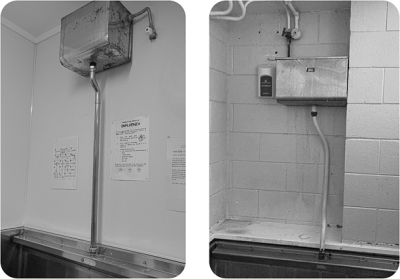Urinal Water Efficiency Guidelines
Reducing water waste from urinals - Saving water helps nature and your budget.
Did you know? Fill and dump urinals flush automatically, every time the cistern is filled- even when it's not being used.
This could waste
300,000
litres every year*
*Based on 15l cistern tank flushing 3 times per hour

Which could cost you
$1400
a year per cistern **
**dependent on your volumetric charge. Check your council water bill for more information
Sensor

Sensor controlled urinals are efficient. When well configured, they maintain water efficiency and cleanliness.
Manual

Manual flush urinals use water only when manually triggered. This makes them efficient.
Waterless Urinals

Waterless urinals eliminate the need for water, making them the most efficient option.
To spot a fill-and-dump urinal look for
- Flushing automatically around every 15 minutes
- No push button or pull chain
- Older stainless steel urinals
- No sensor on or above the urinal
- There is no valve with a wire from it before or after the cistern tank
- Can feed one or multiple urinals
Fill and dump urinal examples


Sensor
A solenoid valve and sensor can be retrofitted onto most existing fill and dump urinals cisterns (or tanks), reducing urinal water use by around 75%. Sensor orientation and controller settings such as minimum and maximum flush intervals and flush duration are key in optimizing water use. When well configured they maintain water efficiency and cleanliness, whether they’re used often or infrequently.
Leaking urinals waste a lot of water.
Check for constant flow and fix as soon as possible.

Manual flush
A manual flush valve or pull chain mechanism can be retrofitted onto most existing cisterns. For urinal systems where multiple stalls are fed by one cistern, installing a manual flush valve on each urinal will achieve the greatest reduction in water waste. For tray urinals a well configured sensor based control is typically more efficient.

Flush volume reduction
For further reductions assess the urinal cistern size. The building code recommends 2.5 L per flush per stall or per 600 mm of tray urinal. If the flush volume is greater than this, consider replacing the cistern or installing a volume displacement device in the cistern. Some flush mechanisms allow for adjustment of the flush volume.

Stall
If the existing urinals are old tray urinals, the most economical option may be replacement. Modern ceramic stall urinals which use a manual flush or sensor based control are best. The most efficient of these urinals use less than a litre of water per flush whilst still maintaining cleanliness. Look for the water efficiency label when buying urinals, the more stars the more efficient.

Waterless urinals
Waterless urinals have gained popularity as the most water efficient solution. They eliminate the need for water, making them a recommended option. Maintenance can be more specialized and requires other consumables for hygiene purposes. These factors should be considered when exploring waterless urinal solutions.
Contact a plumber, urinal and urinal controller supplier to discuss your next steps
